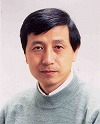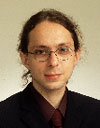|
|
 |
|
|
Foundation of Computer Science Laboratory |

Qian Ping Gu
Professor |

Takafumi Hayashi
Associate Professor |

Lukas Pichl
Assistant Professor |
|
The research and education activities in this laboratory focus on the theoretical foundations of computers and computations. In particular, our work covers the following areas:
- Algorithms and computation
- Programming languages
- Discrete mathematics and applications
The research in this laboratory is divided into two parts. The first part consists of the work that follows the research in the above areas. The goal of this research is to provide the theoretical foundations for the education and research activities in this university.
The second part of our work is the creative research in some specific areas of the theoretical foundations of computer science. Currently, we are working on
- Parallel computation
- Network communication
- Applications of descrete/combinatorial mathematics
The recent impressive advances in VLSI and fiber optics technologies have made it possible to design and build high-performance parallel computers and computer networks. Research in parallel computation and network communication has become one of the most important areas in computer science and is accelerating at a rapid pace.
|
| [lukas-001:2001] | S. Zou, L. Pichl, M. Kimura, and T. Kato. Total and differential
corss section calculations fro proton-mpact ionization of hydrogen at
low energies. Physical Review A, 66:042707-1 to 042707-13, 2002.
We have computedthe single-differential and total ionization cross sections for
the proton-hydrogen collision system at low energy range (0.1-10 keV/amu),
using the electron translation factor corrected close-coupling method. Full
convergence of ionization cross sections as a function of H2+ molecular ba-
sis size was achieved by including up to 10 bound states, and 11 continuum
partial waves. The present results are compared with the available exper-
imental data and various theoretical models. Our calculated cross sections
are in an excellent agreement with the recent experiments of Shah et al. J. Phys. B. 31, L757(1998); inquat:end, but decrease more rapidly
than the cross sections measured by Pieksma et al. inquat:start Phys. Rev.
Lett. 73, 46(1994)inquat:end with decreasingenergy.We havefound that the
1s-sigma g electron ionization is a rather higher-level ladder climbing process
than a direct mechanism; the 2p-sigma u electron, on the contrary, is ionized
directly, and the higher levels act as a temporary trap.
|
| Referred Proceeding Papers |
| [takafumi-001:2001] | Takafumi Hayashi. Two dimensional binary pattern exhibiting zero correlation over a wide range of phase shifts. In SICE2001,
pages 361-364. SICE, SICE, Jul. 2001. |
| [takafumi-002:2001] | Takafumi Hayashi. A class of two-dimensional binary sequence with zero-correlation-zone. In ISPACS2001, pages 291-295. IEEE, IEEE, Nov. 2001. |
| |
| [lukas-002:2001] | L. Pichl, V. Ryzhii, and J. Horacek. Electron transport in multilayer quantum dot structures: tunnelling phenomena. In Computational Physics of Transport and Interface Dynamics. MPG, Springer, 2002. |
| [lukas-003:2001] | L. Pichl, M. Kimura, I. Shimamura, and R. J. Buenker. Charge transfer in ion-atom type collisions (O++H2, He+++H). In Meeting Abstracts of the Physical Society of Japan, 2001. |
| [lukas-004:2001] | S. Zou, L. Pichl, M.Kimura, and T. Kato. Molecular-state study for slow proton-hydrogen collisions. In Meeting Abstracts of the Physical Society of Japan, 2002. |
| [lukas-005:2001] | L. Pichl, V. Ryzhii, J. Horacek, and M. Kimura. Electron tun-
neling rate from non-spherical quantum dots. In Meeting Abstracts of
the Physical Society of Japan, 2002. |
| [lukas-006:2001] | L. Pichl, M.Kimura, andR. J.Buenker. The role of excited states
of target and projectile in the O+/H2 collision. In Meeting Abstracts
of the Physical Society of Japan, 2002. |
| [takafumi-003:2001] | Takafumi Hayashi. Novel CDMA systems by using a class
of binary sequences with orthogonal subsequences and zero-correlation
zone. In Technical Report of IEICE, volume 42, pages 7{14. IEICE,
IEICE, Oct. 2001. |
| [takafumi-004:2001] | Dipak Basu, editor. Dictionary of Pure and Applied Physics
(Comprehensive Dictionary of Physics, chapter terms on ELECTRICITY
and GEOMETRICAL OPTICS. CRC Press, LLC, Dec. 2001. |
| [lukas-007:2001] | Lukas Pichl. Establishment of the control of molecular reactions
by lasers, JSPS Grant-in-Aid: Scienti??c Research (C), 13P01073, 2001-
2002. |
| [lukas-008:2001] | Lukas Pichl, March 2002.
Member,IEEE |
| [takafumi-005:2001] | Takafumi Hayashi, 2001.
Vice Chair, JSAP |
| [lukas-009:2001] | Lukas Pichl andTakuyaYamano. UtilityModel Right: Random-
ization Method for Wrist-watch Display, No. 2002-1298/004817, March
2002. |
| [takafumi-006:2001] | Masashi Sanjo. Graduation Thesis: Performance of ASCDMA system with zero-correlation zone sequence, University of Aizu, 2001.
Thesis Advisor: Takafumi Hayashi |
| [takafumi-007:2001] | Hideo Takeda. Graduation Thesis: Far-near problem of ASCDMA system, University of Aizu, 2001.
Thesis Advisor: Takafumi Hayashi |
| [takafumi-008:2001] | Hidetoshi Otsuka. Graduation Thesis: A simple computation
of the Euler index of a Voxel data, University of Aizu, 2001.
Thesis Advisor: Takafumi Hayashi |
| [takafumi-009:2001] | Takayuki Okamoto. Master Thesis: Novel Airlink Security
for Wireless LAN Systems, University of Aizu, 2001.
Thesis Advisor: Takafumi Hayashi |
| [takafumi-010:2001] | HachirouMeguro. Master Thesis: Research onANovel Meta-Search Engine, University of Aizu, 2001. |
| [takafumi-011:2001] | Takafumi Hayashi. Networking academy. Networkink academy is started, 2001. |
| [takafumi-012:2001] | Takafumi Hayashi. IT-Adivisor for Satiama Prefecture. Networkink academy is started, 2001. |
| [takafumi-013:2001] | Takafumi Hayashi. IT-Adivisor for Fukushima Prefecture. Networkink academy is started, 2001. |
| [takafumi-014:2001] | Takafumi Hayashi. IT-Adivisor for Fukushima Prefecture.
Aizu-Wakamatsu City, 2001. |
|